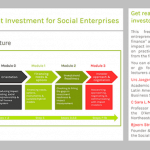Redefining ‘Business as Usual’: Three Ways to Overcome Barriers to ESG and Climate Finance
It has long been clear that business as usual – prioritizing profits over all else – won’t ensure the long-term needs of people, or of the planet we share. But as the negative impacts of global challenges like climate change grow, it’s becoming increasingly apparent that business as usual won’t even work for businesses themselves.
Recently the Financial Stability Oversight Council, a U.S. government body tasked with identifying risks to the country’s financial system, released a report warning that climate change poses an “emerging threat” to America’s financial systems and economy. With climate-related impacts ranging from warming temperatures and rising sea levels, to droughts, wildfires and intensifying storms, climate change already imposes significant costs on the economy. Addressing this crisis is key to businesses’ long-term success and viability.
Meanwhile, most people – 79% overall and 90% of investors under age 45 – say they want to invest in socially and environmentally friendly ways. Yet despite the growing urgency of the need, the increasing interest among investors, and the business case for moving toward environmental sustainability, actual green investing hovers at just 10%, according to research by investment firms. So what accounts for the gap between investor interest and action? And more importantly, what can we do to bridge it?
The Problem of Misleading Information, Misinformation and Missing Information
Information has played a crucial role in creating and perpetuating this gap – specifically misleading information, misinformation and missing information. The corporate ESG ratings from MSCI, the largest environmental, social and governance (ESG) rating company, provide an example of how easy it is for ESG information to mislead its intended recipients. Based on the name, one would expect ESG ratings to measure a company’s impact on society and our planet. Instead, as critics have pointed out, in MSCI’s case they measure how much a company’s efforts to improve its social or environmental impact are likely to affect its profits.
For instance, McDonald’s is one of the world’s largest beef purchasers, and it generated more greenhouse gas emissions in 2019 than entire countries. But MSCI excluded carbon emissions from its ESG rating for McDonald’s, calling them irrelevant – as long as regulations aimed at protecting the environment in the countries where the company does business don’t threaten its bottom line. This approach contributes to the problem of misleading information – an issue that is compounded by the prevalent use of MSCI’s ratings: Nearly 90% of S&P 500 stocks have landed in ESG funds based on MSCI ratings.
But misleading information is only part of the problem, as misinformation is also common across the sustainable business sector. For example, fossil fuel companies have engaged in ever more blatant greenwashing, touting clean energy in their annual reports and strategies but showing little progress in changing their actual business practices.
Whether it involves misleading information or misinformation, this lack of transparency has a real impact on companies that truly are adopting sustainable approaches. Investors track ESG information as part of their portfolio review and investing strategies, so when information is misleading or deceptive, they are unsure of where to put their capital – a situation that can result in fewer sustainable businesses receiving funding that could have gone to more deserving companies.
Missing information also contributes to this gap. Even if they’re not actively greenwashing, most companies don’t publish information about their emissions or other environmental impacts. And the information they do share often contains jargon or inconsistent terminology. Each ESG rating provider uses its own arcane definitions, metrics and systems, generally without regulatory oversight, rendering comparability nearly impossible. Investors and advisors are left to flounder in the mire of these different sources of information, contributing to the misperception of ESG investments as riskier, more volatile or lower-performing. In reality, during the last decade, most ESG funds have performed better than the market as a whole.
Three Ways to Address the Challenges Facing ESG and Climate Finance
What can the sector do to address these issues? First, we need transparent standards and standardized terminology coupled with reporting and disclosure requirements, along with independent, authoritative ESG certification. Consumers and investors need to be able to learn about a company or investment’s impact, and feel confident both in the veracity of ESG information and in their abilities to compare and evaluate that information.
Steps have already been taken in this direction. For instance, the International Business Council’s Stakeholder Capitalism Metrics provide a set of standardized disclosures based on existing SDG-related standards involving society and the environment, which can be used for comparability by any industry or region. Over 60 companies have already committed to report on these metrics. Even the U.S. Securities and Exchange Commission is moving toward requiring disclosure and transparency on greenhouse gas emissions from publicly traded companies.
We must build on this momentum by providing guidance on ways that these disclosures could be used to provide greater financial and green returns on investment for shareholders, to spur innovative financial approaches such as blending public and private finance packages, and to avoid exacerbating inequities in the communities where these companies operate.
Second, we need to build partnerships across sectors – including among policymakers, the nonprofit sector, banks and banking associations, and businesses – to advance sustainable finance and business practices. We need to bring competitors together to find common ground in greening profitable supply chains, as Pact, my organization, did with Nestle and JDE Peet’s in the coffee sector, and with the 14 signatories of the Sustainable Coconut Charter for the coconut sector, under USAID Green Invest Asia. We also need to foster peer-to-peer knowledge sharing, within and between sectors and countries, to spread the word about what works and doesn’t work, and how best to unlock and spur green finance.
Finally, we need to mobilize consumer and investor pressure, harnessing the powers of market, purse and ballot box to demonstrate that transparency and accountability can lead to green and responsible profit. As consumers and investors, we can drive market demand for improved practices through the products we purchase and the investments we choose. We can also press for change by supporting candidates, policies and legislation that are supportive of the transparency necessary for us to be able to buy and invest sustainably.
Green finance is good for people, the planet and business – without it, many companies’ long-term viability is at risk. I believe green finance can – and must – be a key part of our shared efforts to redefine the concept of “business as usual.”
Roger-Mark De Souza is Vice President of Sustainable Markets at Pact.
Photo courtesy of Brian Clark/Pact.
- Categories
- Environment, Impact Assessment, Investing



